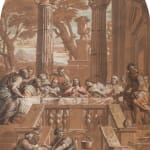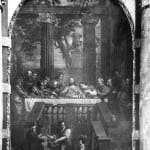Open a larger version of the following image in a popup:


Jan Erasmus Quellinus, The Last Supper (1690).
Onze-Lieve-Vrouw-over-de-Dijle, Mechelen.
Jan Erasmus Quellinus (Antwerp 1634 - 1715 Mechelen)
A Preparatory Drawing for 'The Last Supper'
brush and brown washes, watercolour, heightened with white, over pencil, on laid brownish paper
680 x 435 mm
signed and dated 'Quellinus Pict(or) A(d). Cub(iculum). / Caes.(arae) Maj.(estatis) F. / A. 1689'
Influenced by 16th-century Venetian masters - and in particular Paolo Veronese - Jan Erasmus Quellinus depicts The Last Supper as an exuberant and festive happening in an elegant setting in...
Influenced by 16th-century Venetian masters - and in particular Paolo Veronese - Jan Erasmus Quellinus depicts The Last Supper as an exuberant and festive happening in an elegant setting in open air. In front of a classical architecture with monumental column and grand stairs, Christ is shown sitting down at a set table, surrounded by his twelve apostles. To the right sits Judas, the only one who is standing in the shade. In his left hand he is holding the bag of 30 silverlings, symbol of (and reward for) his betrayal. Again following Venetian examples, at the bottom of the stairs Quellinus has depicted a couple of servants. On the base of the left banister is an elaborate inscription, reading J Quellinus Pict. A. Cub. Caes. Ma.tis. F. A° 1689, leaving no doubt as to the attribution of this very large (680 x 435 mm) sheet to the Antwerp master Jan Erasmus Quellinus.
Jan Erasmus Quellinus was born into the famous Antwerp artist's dynasty of the Quellinus'. His father was the painter Erasmus II Quellinus; his uncle the famous baroque sculptor Artus Quellinus. Taught by his father, he continued working in the latter's classicist style, infusing it with the grandeur of Veronese, with Palladian architectural elements and with a great eye for detail. Quellinus knew the work of the Venetians intimately, as he had studied it in situ while staying in Venice in 1660-1661. Around 1680 he travelled to Vienna, where he worked for the Habsburg court and was appointed court painter to the Emperor Leopold I. This also explains his elaborate signature in the present work: Pict(or) A(d). Cub(iculum). Caes(arae) Ma(jestatis), which translates roughly as "painter to the chamber of his Majesty the Emperor".
The altarpiece for which this large gouache is the final preparatory drawing, or even the presentation sheet intended for the patron(s) of the painting, has been preserved to this day. The final composition can be found hanging above the high altar of the church Onze-Lieve-Vrouw-over-de-Dijle in Mechelen, and is dated 1690 - indicating that is was painted straight after the design, which is dated 1689, was approved (see illustration). This Final Supper is nearly identical to our sheet, apart from a few minor differences. Interestingly, it is already mentioned by Jean-Baptiste Descamps in his Le voyage pittoreque de la Flandre et du Brabant (1769); clearly it was seen early on as one of Quellinus' most important commissions. The fact that both the presentation or preparatory drawing and the final altarpiece have been preserved is quite rare in 17th-century Flemish baroque art. There exists another drawing by Quellinus, currently in the Schlossmuseum in Weimar (Stiftung Weimarer Klassik und Kunstsammlungen, Weimar (Thüringen) , inv./cat.nr KK 5310), where we see the same group of Christ with his apostles, with the same Judas figure to the right. Possibly this work can also be seen as part of the preparatory work for the painting in Mechelen.
Provenance
European private collection.


